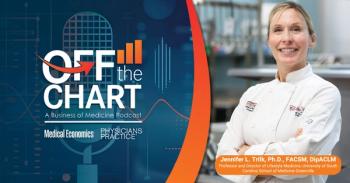
Cash and Carry Healthcare Has Evolved
The future of the direct-pay practice model is bright. Here's how it works, the affect on patients, and where it fits with models promoted by healthcare reform.
Ten years ago no one thought it could work. Not taking insurance, not being in any PPO networks, refusing to make the burden of insurance filing overhead my own, I opened my cash and carry practice on April Fool's Day almost a full decade ago.
I had seen the strain on patients without insurance who could not afford to pay for simple follow-up visits or health maintenance screenings. I had witnessed firsthand the burnout of primary-care physicians working around me on a treadmill of widget production, trying to see enough patients each day to keep their doors open. I knew there had to be a better mousetrap.
After reading and researching various models of healthcare delivery, I spent about 18 months designing a practice structure that would address these problems. Uninsured patients had to somehow have access to discounted cash rates. Physicians had to be able to spend more time with patients and not feel like they had to run room to room.
What I have discovered over the years is that my innovation is really just a throwback to 50 years ago. Patients once paid their physicians directly, sometimes with cash, sometimes with chickens, sometimes with seed. A doctor's office usually had only one staff person at that time. That person did not have to submit insurance claims, appeal rejected claims, or worry about proper coding and modifiers. They helped the physician check patients in and out and assisted with procedures. Wouldn't it be nice to go back to that simpler time? Well, that's exactly what I did. By shunning all insurance contracts, permanently opting out of Medicare, and integrating modern technology with the simplicity of the past, I created a low-overhead, direct-pay practice model.
Ten years later we have about 6,000 patients in our micropractice. We save uninsured patients about 85 percent overall on their outpatient healthcare costs through reduced fees. We have been identified as one of 28 Cardiovascular Centers of Excellence in the United States. Our outcomes measures such as HgbA1C, average LDL, and percent of patients at their blood pressure goals are in the top 10 percent nationally based on audits done as part of a CQI program conducted by COSEHC and evaluations done by fourth-year UNC Chapel Hill medical students participating in a "New Models of Care" elective.
The big surprise to me is that 53 percent of our patients have traditional insurance. I anticipated an almost entirely uninsured clientele when I opened, but word of mouth about short wait times and hour-long office visits made insured patients in our community envious of those treated at our office, and so they came. It turns out that most patients value the attributes of a direct-pay practice more than the hassle of filing their own insurance. Medicare patients frustrated with not being able to find a physician accepting new patients or with the patient mill they have experienced in the past have come in droves. They find that paying the physician directly gets them more time, more attention, and a better medical experience. They sign their private contract and find that their out-of-pocket cost for the year is similar if not less than what it was when they saw a Medicare provider.
Skeptical? Here's some simple math: If a patient has Medicare Part A and Part B and no supplemental insurance they are responsible for 20 percent of the bill. Remember, I said our rates are 85 percent less than typical fees. This means with no supplemental insurance our patients might save 5 percent. Moreover, look what Medicare saves, as it has never been billed for any of the 10,000-plus Medicare-eligible visits to my practice. If there were 1,000 practices like mine, Medicare might be solvent again.
How it works
Patients can either pay a la carte from a posted menu of services in the waiting room or they can pay $29 per month and $20 per visit. On the a la carte menu, the most expensive visit is $49. Ancillary services such as labs, splints, and injections are charged at nominal fees like $25 to $36. Patients can actually add up their own bill before they are seen if they know what they will need.
For those that pay monthly, we give them an "Access Card" that allows them to come in whenever they want for a typical overhead charge of $20 that includes most ancillaries and labs. The idea is that patients are paying their provider directly each month for managing their healthcare. That becomes the profit. When they actually use services, we simply make sure that their charge covers our overhead associated with that visit. This means that if you have 1,000 patients paying you $29 per month for your services, and if the per visit fee is just enough to cover your overhead, then your take-home salary is a reasonable $348,000 per year and your salary is no longer volume dependent. If you want to look after 2,000 patients you could probably handle that, too.
We are not concierge. The one criticism I get most often is that "concierge practices like ours" cater only to the wealthy and that if everyone practiced this way the physician shortage would be even worse. Such criticism of concierge practices is valid, but those criticisms do not describe our model. In concierge practices, the management fee, or annual fee, or executive physical fee is typically over $1,000 per year - and in addition to that annual fee, most concierge practices continue to bill insurance or Medicare.
We have never had a patient spend over $1,000 out-of-pocket in a year. On average, a hypertensive, diabetic, hyperlipidemic patient normally spends around $500 per year for all of their care with us. That usually includes a comprehensive physical with an EKG, quarterly labs like HgbA1C, lipids, and metabolic panels, and on average five 45-minute to 90-minute visits per year. So, we are not concierge, although from a physician and patient standpoint we have many of their benefits.
The key to making a direct-pay model work is keeping overhead low. If you are charging 85 percent less, then your collections need to be near 100 percent (99 percent for us) and your overhead needs to be much lower than the traditional 50 percent to 60 percent. My practice overhead was about 25 percent last year. There is a lot of planning and efficient use of resources that goes into that.
Among the essential efficiencies is staffing. We have two physicians, one full-time nurse practitioner, and one full-time and two half-time medical assistants. Essentially we have 0.66 FTE per provider instead of the normal 4.5 and that is the key to keeping the overhead down. For someone who is solo, they would need one full-time medical assistant and that's it. No coders, no billing clerks, no office manager, no RN, no receptionist (the medical assistant does that). That's how you can break even with overhead seeing only four patients per provider per day.
What about the Patient-Centered Medical Home model and the Idealized Practice from the Future of Family Medicine Report? Our practice model is an example of both. We use a CCHIT-certified EHR, referral tracking, registries, care coordination, continuous quality improvement, practice redesign, patient satisfaction surveys, electronic patient communication and reminders, and most of the other features that help ensure a patient-centered practice that is financially viable. Best of all, our model is sustainable since it is immune to the whims of payers. The PCMH model is not mutually exclusive of direct pay. They coexist quite nicely. Ideally, every primary-care practice should be a medical home, because that really does offer the highest quality cost-effective care. However, practices implementing the PCMH model in a traditional payer environment are going to continue to be challenged unless real payment reform that rewards the model comes to pass.
In a world of Medicare RAC audits, Red Flag rules, stagnant reimbursement, and the certainty of further Medicare/Medicaid cuts looming, physicians are looking for a way out of the current complex system into a new practice model-world where the doctor-patient relationship is at the core of healthcare again rather than the third-party payer.
The future of the direct-pay practice model is bright. It may become the main source of care for patients who want quality, affordable, accessible, and transparent healthcare.
Brian Forrest, MD, is an adjunct associate professor at the UNC Chapel Hill Department of Family Medicine where he teaches an elective class called "New Models of Care." He is the founder of Access Healthcare, a COSEHC Cardiovascular Center of Excellence. He is also president of
This article originally appeared in the January 2011 issue of Physicians Practice.
Newsletter
Optimize your practice with the Physicians Practice newsletter, offering management pearls, leadership tips, and business strategies tailored for practice administrators and physicians of any specialty.














